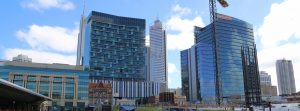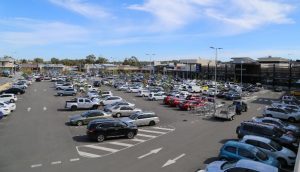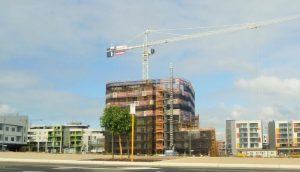Office
- Headline Vacancy Rate: Perth CBD 25.2% (January 2017), West Perth 20.4% (July 2016) and suburban, 16.5% (November 2016).
- There is now over 4 million sq m of office space across metropolitan Perth. Currently over 825,000 sq m of office space is vacant.
- Main driver of current vacancies is downsizing in the iron ore and engineering sectors, combined with unoccupied new supply and secondary stock by tenants upgrading to higher quality accommodation.
- There is strong competition for tenants larger than 500 sq m especially outside the core of the CBD. However, Perth is more than the just the Central Business District. Our suburbs play a key role beyond housing in driving local employment. Relocating suburban tenants into the CBD has the potential to create harder to lease large vacancies in suburban locations.
- The CBD’s biggest space occupier, the State Government, has announced plans to de-centralise 25,000 sq m of office space to Fremantle and Joondalup. This will see the amount of occupied space fall in the CBD by 2.6% by the end of the decade.
- With incentives offering the equivalent of 5 years rent free now common place and space available for as low as $100 per sq m in the Perth CBD, there is limited scope for further discounting. Cuts to real not effective rents will be required in 2017.
- The development wave that has seen office space the equivalent of 14 Brookfield Places built across Perth is nearly complete. The new Woodside Building in the CBD, Subi XO, 25 Rowe Avenue in Rivervale and the new Joondalup House are the major office projects currently under construction across Perth.
- Given recent leasing transactions, the current level of CBD and suburban vacancy is not expected to increase significantly from current levels. Woodside’s relocation to its new headquarters, in 2018, has the potential to drive the CBD vacancy rate slightly higher.
- Property owners need to create a point of difference with their property. Price or quality will be the two factors that shape tenant decisions.
- Looking at global trends, how do we S.T.E.M future vacancies – focus on growth occupiers, shared work spaces, technology, education and medical. Over the past 4 years the proportion of CBD office stock occupied by these sectors has increased by over 20%. Improved market affordability post the resources boom has been the key driver of absorption.
- Perth still suffers from a lack of tenant diversity. At the peak of the boom in 2012, 70% of occupied office space in the Perth CBD was occupied by resources companies, firms servicing the resources industry and the Government. This has not changed significantly in the ensuring years.
Retail
- Amid a backdrop of the end of the resources boom, slowing population growth, lacklustre retail sales’ growth and weak consumer confidence, shopping centre owners and developers are set to invest over $4.5 billion dollars in a long awaited record wave of new development.
- This investment will be a key source of employment growth in Perth’s property and construction markets as office and industrial development slow.
- As of May 2016, there were 42 shopping centre developments across metropolitan Perth that were either completed since 2015, under construction or actively progressing through the development approval processes.
- Major 2016 completions included Stockland Harrisdale, Coles Byford, Caversham Village, Port Coogee Marina, Mandurah Central, Woolworths Averley and Coles Riverton.
- The expansion into WA of Aldi has driven a significant proportion of development. Since the 8 June 2016, Aldi has opened 17 stores of typically 1,500 sq m.
- Over 425,000 sq m of extensions to existing shopping centres is planned to occur by the end of the decade. Major regional shopping centres such as Carousel and Garden City are evolving into more than retail destinations. To draw in online shoppers, centres are concentrating on the physical experience of shopping, attracting new international retailers into local centres and offering a range of services focusing on dining, entertainment and community facilities.
- Aside from Mandurah Forum and a new dining precinct at Whitfords City, construction is yet to commence on any of the Major Regional Centres redevelopments. Construction at AMP Centres, Karrinyup and Garden City, and Scentre Group centres, Carousel and Innaloo, are forecast to commence construction in 2017.
- Large Format retail in Perth is adjusting to the closure of Masters Superstores in the last quarter of 2016. Development is slowing as Bunnings slow their store expansion.
- The new DFO at Perth Airport is expected to be the largest new development to commence construction in 2017. Future growth is expected in areas around Butler, Ellenbrook and Perth’s southern corridor.
Apartments
- Similar to the general housing market, apartment development is falling from mid 2016’s supply high. Just over 3,000 new apartments were completed across 2016.
- Slowing population growth, consumer preference for house and land packages, and vacant existing supply are limiting development. Perth’s 6.6% housing vacancy, combined with a 7% reduction in rents in the year to September 2016 (REIWA), is also limiting construction.
- Apartment sales are slowing – just over 1,000 apartments were sold in new developments across 2016. Less than 10 projects were launched in the second half of 2016 as developers adjusted to new market conditions.
- Apartments of 3 or more storeys remain a small but visible proportion of WA’s housing stock, accounting for less than 5% of Western Australia’s dwelling stock.
- The recent increase to the First Home Buyers Grant is unlikely to have significant impact on the apartment market. In the last 10 years, only 4 suburbs with more than 500 apartments have made the Top 20 list of first home ownership grants awarded on a yearly basis.
- Unlike eastern states markets, international sales play a limited role in Perth’s apartment market (approximately 5-10%). Owner/occupiers, particularly downsizers, are the dominant occupiers of Perth’s apartment stock.
- New State Government policy, Design WA, will improve the liveability but likely add additional cost and uncertainty in the development process.
- Key question remains – Would I live in one? Well located developments, close to amenity, public transport and employment hubs priced for a competitive market are still selling, at a reduced rate. Comparative pricing to competing housing stock is key. Apartments need to be priced at a discount compared to the general housing market. This allows downsizing owner/occupiers to unlock equity in their houses.
Industrial
- Transition from the construction to production phase of major resource projects has significantly impacted metropolitan markets. According to industry sources in late 2016, there is between 525,000 and 800,000 sq m of industrial property vacant. Amount of vacant space has increased by nearly 20% over the past 12 months.
- Similar to office occupiers, the resources industry downsizing is the major driver of vacancy. Occupiers have focused on reducing costs and staff.
- Ikea’s leasing of over 14,000 sq m of the former K-Mart distribution centre, in Canning Vale, and M3 Logistics on Harrison Road, in Forrestfield, were the largest leasing deals of existing property in 2016.
- Despite this level of vacancy, 2016 was a strong year for supply completions. Jandakot Airport is the current development hotspot with Aldi, K-Mart, Super A-Mart and Aqua Technics relocating to this market. JLL notes a total of approx 180, sq m has completed construction in the last 12 months. This is the highest level of stock completion since 2009.
- New estates are evolving. Shift to transport and logistics firms is forecast to continue. New shopping centre expansions are fuelling demand for warehouses and distribution centres. Proximity to infrastructure key requirement. Estates are evolving to add greater diversity in lot sizes and amenity.
- A high proportion of industrial stock in key markets is over 20 years of age, has limited co-located office/showroom space and was built for the specific use of since vacated tenants. As a result, expect the redevelopment of older, secondary properties in core locations, particularly the eastern suburbs.



